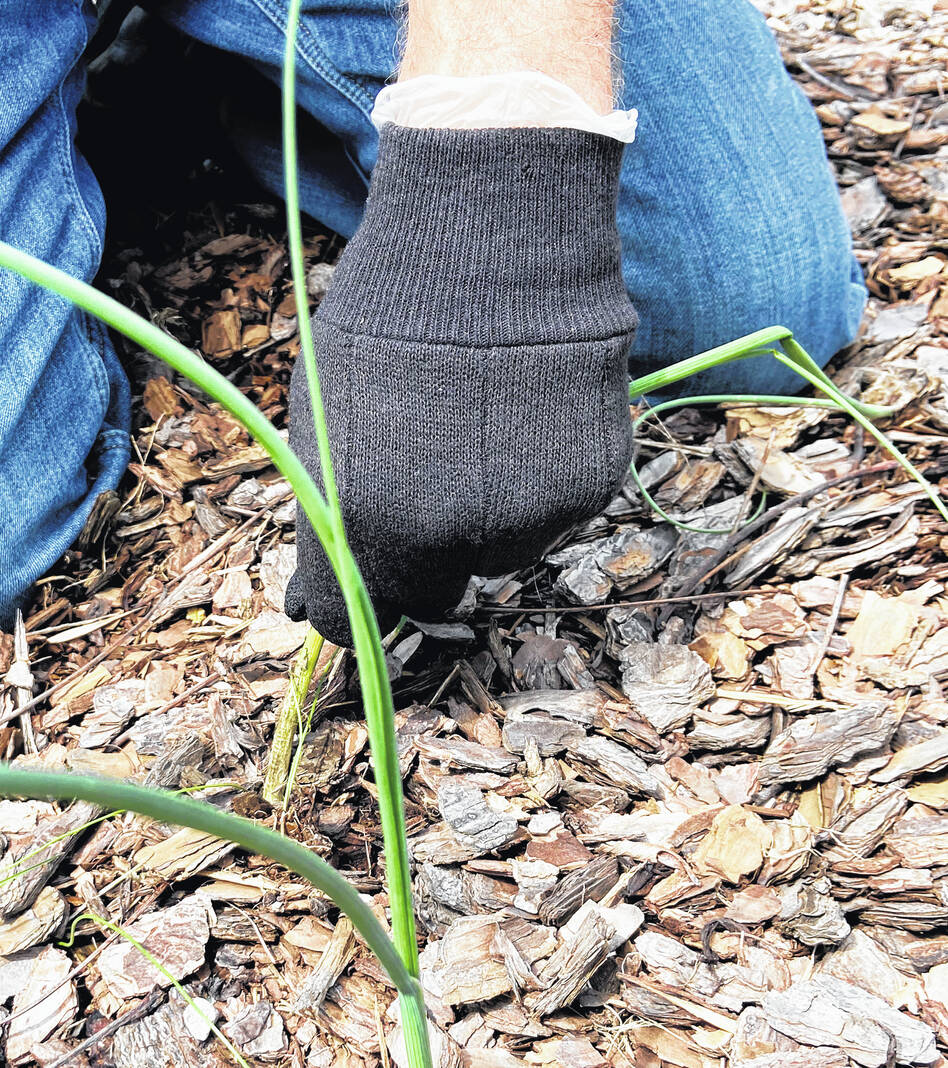

The “Roundup glove” technique is an easy and fast way to kill wild garlic and wild onions in your garden without harming your flowers.
Photo courtesy of GoodSeed Farm
Weed control is the biggest maintenance challenge in most home landscapes. Wild garlic and wild onions might be the hardest weeds to deal with. These plants are made to survive most weed removal methods. Wild garlic plants have round, hollow, tubular leaves, with a grayish-blue powdery coating. Wild onions are flat-leaved and non-hollow, green and waxy. Both plants are a nuisance in gardens and lawns, and controlling them both takes the same recipe.
First, because both of these weeds grow from bulbs and bulblets, which break apart from each other easily, it’s almost impossible to remove an entire clump without leaving some roots behind. Yes, you can dig out a shovel full of garden soil deep enough to get every little bulb, but you’re likely to leave huge divots in your landscape, disturbing your mulch and weed barrier fabric, thus inviting more weeds.
Wild garlic plants have round, hollow, tubular leaves, with a grayish-blue powdery coating. Wild onions are flat-leaved and non-hollow, green and waxy. Both plants are a nuisance in gardens and lawns, and controlling them both takes the same recipe. Wild garlic and onions are uniquely able to penetrate most weed barrier fabrics, pushing thread-like shoots through tiny holes in the fabric and then enlarging the holes as they grow. Since the bulbs are below the fabric, pulling them out is just impossible. The tops just break off in your hand.
Second, the thin waxy leaves make it difficult for weed killer sprays to stick to the leaves. They usually just bead and run off, and, even if they stick, the waxy coating prevents herbicide from penetrating into the plant. To make matters worse, wild garlic and onions are typically growing among desirable plants, so weed killer sprays will likely drift onto your flowers and kill them as well.
Spring is the best time to get the jump on wild garlic and onions. Both are perennial weeds, meaning that they survive the winter and come back stronger each year. In lawns, weed control sprays containing 2,4-D will control them without damaging most lawn grasses. Thick, healthy turf and regular mowing discourage wild garlic and onions from thriving.
Landscape beds are a bigger challenge. 2,4-D and glyphosate (Roundup) will both kill wild garlic and onions, but likely damage landscape plants in the process. How can you apply weed killers without killing your shrubs and flowers?
We’ve come up with an easy method we call the “Roundup glove”. It only takes a few minutes to treat a typical landscape, doesn’t damage desirable plants, and knocks out garlic and onion clumps 100%. Here’s how we do it:
First, visit your local hardware store and get some disposable rubber surgical gloves, and a pair of cheap cotton work gloves. Put a rubber glove on first, then a cotton glove over it. Pour some Roundup into a paint pail or bowl. Dip your gloved hand into it, soaking the cotton glove. Now, walk around your garden. Every time you see a garlic or onion clump, grip it at the base, squeeze and slide your hand up to the top, wetting it completely without touching the surrounding plants.
Keep the cotton glove wet by dipping it repeatedly. You should be able to treat all your garden beds in a few minutes, then remove the cotton glove and toss it into the laundry basket. Peel the rubber glove off and throw it away.
It takes a week or so for the Roundup to penetrate down into the roots and kill the entire clump. Remember that you’ll kill any foliage you touch with your wet “Roundup glove”, so if you have other hard-to-pull weeds (like dandelions) mixed in with desirable plants in your gardens, you’ll be tempted to wet them as well. Do it.
Steve Boehme is a landscape designer/installer specializing in landscape “makeovers”. “Let’s Grow” is published weekly; column archives are online at www.goodseedfarm.com. For more information call GoodSeed Farm Landscapes at (937) 587-7021.

